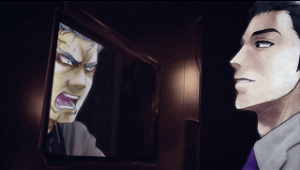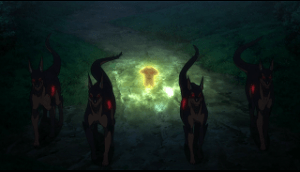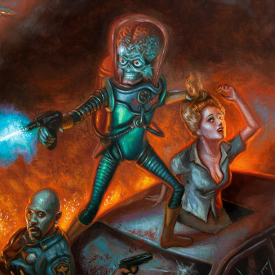 Kagewani #9 – Homma and Kimura are the two sides of Hanlon’s Razor: malice and incompetence. Fresh from trying to grab Satoru and having that end in a flaming shambles, Kimura lets Homma steal Bamba away and then is complicit in leaving Homma locked in with the biochemical spill, as if he doesn’t remember what happened the last time he thought abandoning someone in a room full of monsters was a good idea.
Kagewani #9 – Homma and Kimura are the two sides of Hanlon’s Razor: malice and incompetence. Fresh from trying to grab Satoru and having that end in a flaming shambles, Kimura lets Homma steal Bamba away and then is complicit in leaving Homma locked in with the biochemical spill, as if he doesn’t remember what happened the last time he thought abandoning someone in a room full of monsters was a good idea.
What Kimura does this episode is probably deliberate, with the goal of getting a kagewani of his very own in mind. Still, there’s now a high-level monster loose in a city center, people around the world know there’s a way to turn bunnies into giant mutant killers, and I still have serious doubts about Kimura’s ability to control a kagewani in the same way Bamba can.
Speaking of serious doubts, the magic velociraptor-creating serum is the latest version of the currently popular trope of the bioweapon that has no actual use other than creating hordes of implacable zombies, monsters, or what have you for the heroes to fight. I mean, what exactly is its military value supposed to be? In a war, you’re either trying to kill the enemy, neutralize them in some way, or persuade them to give up fighting. Turning them into efficient killing machines which are completely immune to psyops does not seem to work toward any of those goals.
 Re: ZERO -Starting Life In Another World- #9 – You’d think that Subaru could have figured out sooner that being bitten by a puppy would be bad news, but I suppose we can assume that he was too focused on figuring out the curse to be worried about rabies.
Re: ZERO -Starting Life In Another World- #9 – You’d think that Subaru could have figured out sooner that being bitten by a puppy would be bad news, but I suppose we can assume that he was too focused on figuring out the curse to be worried about rabies.
So the puppy is our shaman in disguise, who has summoned an army of hellbeasts and stolen away the children of the village for… um… I guess that’ll have to be explained next time. The curse was never aimed directly at anyone in the mansion, though Roswaal’s sudden errand this time around suggests that there’s some kind of connection.
And, as broadly hinted for the last two or three episodes, Ram and Rem are in fact oni in human guise. What this means is not clear without more of a framework to fit it in. Is this something oni commonly do in this fantasy world? Is Roswaal showing off by having powerful evil creatures serving him as maids? Is he sheltering them from something or someone?
 Concrete Revolutio #21 – It’s 1974, and the real reason for the sudden drop in Middle Eastern oil production is an uprising of native spirits. (Against Western imperialism? Against Salafist oppression of pre-Islamic powers? As part of an environmental movement? I don’t suppose we’ll ever get a fuller explanation.) And it turns out that in all the chaos of the last few years, no one ever got around to telling Jirō his origin story or letting him know that his blood is a magic serum that makes superhumans even more super.
Concrete Revolutio #21 – It’s 1974, and the real reason for the sudden drop in Middle Eastern oil production is an uprising of native spirits. (Against Western imperialism? Against Salafist oppression of pre-Islamic powers? As part of an environmental movement? I don’t suppose we’ll ever get a fuller explanation.) And it turns out that in all the chaos of the last few years, no one ever got around to telling Jirō his origin story or letting him know that his blood is a magic serum that makes superhumans even more super.
Now that he’s finding out via the helmet containing some remaining fragment of Claude’s personality, it feels like we have a story again. Understanding what he is, and finally sorting out who’s actually trying to stamp out superhumans and how, looks like the thing that will bring it to a conclusion.
The evil plot will culminate in the release of a nationalistic tokusatsu movie which will somehow lead to a time with no superheroes at all. (I guess they’re not going to be the good guys in the movie.) That’s one of two moments when the guy from Imperial Ads seems to be imagining a timeline more like ours. The other is of course when he confronts Dr. Hitoyoshi about what happened in Hiroshima. He’s figured out that there should have been an explosion and that something intervened.
It looks increasingly like this is all going to end with someone modifying the past to wind up with our timeline. At least three people now have access to time travel technology (Jaguar, Earth Girl, and remember that Dr. Hitoyoshi had a chance to study Jaguar’s watch), and there’s no reason to set all that up if it’s not going to be used.
(Daisuki – FUNimation – FunimationNow – AnimeLab – ADN)
 My Hero Academia #9 – As they say, Īda is totally the class representative type. This episode is mostly about moving the pieces around so he can settle into his stereotypical role. For Americans confused by the “Exit Sign Guy” nickname, most of the world uses a pictogram of a running man to indicate exits. (See this article for an example and discussion.)
My Hero Academia #9 – As they say, Īda is totally the class representative type. This episode is mostly about moving the pieces around so he can settle into his stereotypical role. For Americans confused by the “Exit Sign Guy” nickname, most of the world uses a pictogram of a running man to indicate exits. (See this article for an example and discussion.)
A bigger deal for the long-term story is the further demonstration of Katsuki’s loss of status. At his old school, he was the kid at the top of the heap getting all the praise; at this one, most of the class has figured out that he’s a jerk and he’s even getting teased.
Well, and a bunch of All Might’s old nemeses showing up in the middle of a training exercise is a big deal too. Assuming that is them and not a really clever simulation, of course. But they’re led by the same guy who was being menacing outside the school earlier, so I’m presuming that this is for real.
(FUNimation – FunimationNow – AnimeLab – ADN)
 The Lost Village #9 – I think Nanko is on the right track when she theorizes that the village and the monsters are there for the purpose of helping people come to grips with their fears. After some exposure therapy, some people are starting to lighten up and decide things aren’t so bad. Becoming more resistant to the monsters allows people to pass through the tunnel to the next village– the next step in their rehabilitation.
The Lost Village #9 – I think Nanko is on the right track when she theorizes that the village and the monsters are there for the purpose of helping people come to grips with their fears. After some exposure therapy, some people are starting to lighten up and decide things aren’t so bad. Becoming more resistant to the monsters allows people to pass through the tunnel to the next village– the next step in their rehabilitation.
When Mitsumune sees his fear again after passing through, it’s smaller. And it’s become something that he wants to follow and investigate rather than run away from.
Much has been made of Masaki’s inability to see monsters, but there have been at least two other people who never, from the start, saw anything they wanted to run away from: Yottsun and the bus driver. Masaki does have one up on them, though, in that she also doesn’t see anything or anyone beckoning to her.
Even though Mitsumune is the one in the foreground, it’s the driver who is once again, er, driving the story. Though Masaki has been through the tunnel, the driver is the one who takes the narrative there. I’m still convinced he’s the actual protagonist.










